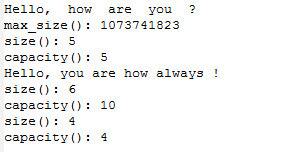【STL记录】Containers--Vectors
2016-07-23 00:00
337 查看
摘要: vector的基本用法
Vector类似于一个动态数组

使用vector,需加入头文件:
Vector提供随机访问,如果知道元素的位置,可以直接访问元素。
当在尾部插入和删除元素时,vector表现很好;但在中间或前端插入、删除元素时,则较慢。
capacity的重要性有两个方面:
再分配(reallocation)使得vector的引用,指针和iterators都失效
再分配(reallocation)需要花费一定时间
为了避免再分配(reallocation),可以使用reserve()函数来确保capacity:
调用reserve()并不能收缩容量(capacity)。如果调用reserve()的参数小于当前的capacity,那么这个操作是no-op。
如果没有调用reserve()设置容量,在插入数据前,将分配一块内存(例如2K)来存放数据,这样就会造成内存浪费。
C++11介绍了一个新的函数:a nonbinding request to shrink the capacity to fit the current number of elements
Table 1.Constructors and destructor
Insert and Remove Operations
例如,移除第一个元素:
输出:

Vector类似于一个动态数组

使用vector,需加入头文件:
#include <vector>
一、Abilities of Vectors
Vector复制所有元素到它的内部动态数组中。通常这些元素是有一定顺序的,因此vector是一种有序集合。Vector提供随机访问,如果知道元素的位置,可以直接访问元素。
当在尾部插入和删除元素时,vector表现很好;但在中间或前端插入、删除元素时,则较慢。
1.Size and Capacity
Vector除了提供常用的操作size(),empty(),和max_size(),还提供了一个capacity()函数,用来返回一个vector在它的实际内存中所包含的元素个数。一旦超出了这个capacity,vector将从新分配它的内部内存。capacity的重要性有两个方面:
再分配(reallocation)使得vector的引用,指针和iterators都失效
再分配(reallocation)需要花费一定时间
为了避免再分配(reallocation),可以使用reserve()函数来确保capacity:
vector<int> v; //create an empty vector v.reserve(80); //reserve memory for 80 elements
调用reserve()并不能收缩容量(capacity)。如果调用reserve()的参数小于当前的capacity,那么这个操作是no-op。
如果没有调用reserve()设置容量,在插入数据前,将分配一块内存(例如2K)来存放数据,这样就会造成内存浪费。
C++11介绍了一个新的函数:a nonbinding request to shrink the capacity to fit the current number of elements
v.shrink_to_fit(); //request to shrink memory
2.Constructors and destructor of vector
| Operation | Effect |
| vector<Elem> c | Default constructor:创建一个空的vector |
| vector<Elem> c(c2) | Copy constructor:通过复制c2创建c |
| vector<Elem> c = c2 | Copy constructor:通过复制c2创建c |
| vector<Elem> c(rv) | Move constructor:creates a new vector,taking the contents of the rvalue rv |
| vector<Elem> c = rv | Move constructor:creates a new vector,taking the contents of the rvalue rv |
| vector<Elem> c(n) | 使用默认构造函数创建一个有n个元素的vector |
| vector<Elem> c(n, elem) | 创建一个有n个元素的vector,并且使用elem初始化 |
| vector<Elem> c(beg, end) | 创建一个使用范围[beg,end)初始化的vector |
| vector<Elem> c(initList) | 创建一个使用initList初始化的vector |
| vector<Elem> c = initList | 创建一个使用initList初始化的vector |
| c.~vector() | 销毁所有元素并释放内存 |
二、Vector Operations
1.Nonmodifying Operations
| Operation | Effect |
| c.empty() | 返回容器是否为空(相当于size() == 0) |
| c.size() | 返回当前元素的个数 |
| c.max_size() | 返回可能存在元素的最大个数 |
| c.capacity() | 返回没有再分配的元素的最大个数 |
| c.reserve(num) | 扩展capacity |
| c.shrink_to_fit() | 收缩capacity,适应元素个数 |
| c1 == c2 | 返回c1是否等于c2 |
| c1 != c2 | 返回c1是否不等于c2 |
| c1 < c2 | 返回c1是否小于c2 |
| c1 > c2 | 返回c1是否大于c2 |
| c1 <= c2 | 返回c1是否小于等于c2 |
| c1 >= c2 | 返回c1是否大于等于c2 |
2.Assignments
| Operation | Effect |
| c = c2 | 将c2所有的元素赋给c |
| c = rv | Move assigns all elements of the rvalue rv to c |
| c = initList | 将initList赋给c |
| c.assign(n, elem) | 将值val赋给c的每一个元素 |
| c.assign(beg, end) | 将[beg,end)范围的值分配给c |
| c.assign(initList) | 将initList的值分配给c |
| c1.swap(c2) | 交换c1和c2的数据 |
| swap(c1, c2) | 交换c1和c2的数据 |
3.Element Access
| Operation | Effect |
| c[idx] | 返回索引为idx的元素(没有边界检查) |
| c.at(idx) | 返回索引为idx的元素(当idx超出边界,抛出range-error异常) |
| c.front() | 返回第一个元素(不检查第一个元素是否存在) |
| c.back() | 返回最后一个元素(不检查最后一个元素是否存在) |
4.Inserting and Removing Elements
| Operation | Effect |
| c.push_back(elem) | 将elem附加到末尾 |
| c.pop_back() | 移除最后一个元素,不返回 |
| c.insert(pos, elem) | 将elem插入到pos之前的位置,并返回新元素的位置 |
| c.insert(pos, n, elem) | 在pos之前的位置开始插入n个elem,并返回新插入的第一个元素的位置 |
| c.insert(pos, beg, end) | 将[beg, end)的值插入到从pos之前的位置,并返回第一个新元素的位置 |
| c.insert(pos, initlist) | 将initlist的值插入到从pos之前的位置,并返回第一个新元素的位置 |
| c.emplace(pos, args...) | 将args插入到pos之前的位置,并返回第一个新元素的位置 |
| c.emplace_back(args...) | 将args附加到末尾 |
| c.erase(pos) | 移除pos所指的元素,并返回下一个元素位置 |
| c.erase(beg, end) | 移除范围[beg,end)的元素,并返回下一个元素的位置 |
| c.resize(num) | 设置元素个数为num,如果增长了,使用默认构造函数初始化 |
| c.resize(num, elem) | 设置元素个数为num,如果增长了,使用elem初始化 |
| c.clear() | 移除所有元素 |
vector<Elem> coll;
...
//remove first element with value val
vector<Elem>::iterator pos;
pos = find(coll.begin(), coll.end(), val);
if(pos != coll.end()) {
coll.earse(pos);
}三、Example of Using Vector
#include<vector>
#include<iostream>
#include<string>
#include<algorithm>
#include<iterator>
using namespace std;
int main()
{
//create empty vector for stirng
vector<string> sentence;
//reserve memory for elements to avoid reallocation
sentence.reserve(5);
//append some element
sentence.push_back("Hello,");
sentence.insert(sentence.end(), { "how", "are", "you", "?"});
//print elements separated with spaces
copy(sentence.cbegin(), sentence.cend(),
ostream_iterator<string>(cout, " "));
cout << endl;
//print "technical data"
cout << "max_size(): " << sentence.max_size() << endl;
cout << "size(): " << sentence.size() << endl;
cout << "capacity(): " << sentence.capacity() << endl;
//swap second and fourth element
swap(sentence[1], sentence[3]);
//insert element "always" before element "?"
sentence.insert(find(sentence.begin(), sentence.end(), "?"), "always");
//assign "!" to the last element
sentence.back() = "!";
//print elements separated with space
copy(sentence.cbegin(), sentence.cend(),
ostream_iterator<string>(cout, " "));
cout << endl;
//print some technical data again
cout << "size(): " << sentence.size() << endl;
cout << "capacity(): " << sentence.capacity() << endl;
//delete last two elements
sentence.pop_back();
sentence.pop_back();
//shrink capacity
sentence.shrink_to_fit();
//print some technical data again
cout << "size(): " << sentence.size() << endl;
cout << "capacity(): " << sentence.capacity() << endl;
}输出:

相关文章推荐
- 浅析STL中的常用算法
- STL区间成员函数及区间算法总结
- C++ Vector用法详解
- 详解C++编程中的vector类容器用法
- 详解C++中的vector容器及用迭代器访问vector的方法
- C++实现 vector 的四则运算
- c++ STL容器总结之:vertor与list的应用
- C++在成员函数中使用STL的find_if函数实例
- 大家注意vector, list, set, map成员函数erase
- java中vector与hashtable操作实例分享
- C++ vector删除符合条件的元素示例分享
- 关于STL中list容器的一些总结
- C++中vector容器的常用操作方法实例总结
- 使用C语言实现vector动态数组的实例分享
- C++ Vector用法深入剖析
- vector与map的erase()函数详细解析
- 关于STL中的map容器的一些总结
- 深入理解C++中的vector类的用法及特性
- vector,map,list,queue的区别详细解析
- C++ vector的用法小结
